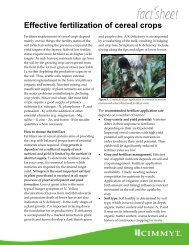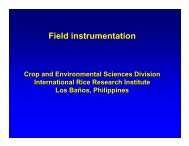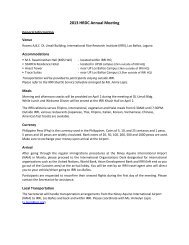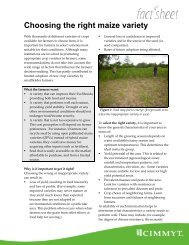Water management in irrigated rice - Rice Knowledge Bank ...
Water management in irrigated rice - Rice Knowledge Bank ...
Water management in irrigated rice - Rice Knowledge Bank ...
- No tags were found...
You also want an ePaper? Increase the reach of your titles
YUMPU automatically turns print PDFs into web optimized ePapers that Google loves.
Yield (t ha –1 )864200 500 1,000 1,500 2,000 2,500 3,000<strong>Water</strong> <strong>in</strong>put (mm)Fig. 3.8. Yield versus water <strong>in</strong>put <strong>in</strong> two experiments <strong>in</strong> India. Top curve data ( ) are from Pantnagar, Uttar Pradesh (Tripathiet al 1986), and bottom curve data ( ) are from Cuttack, Orissa (Jha et al 1981). The curved l<strong>in</strong>es are fitted productionfunctions of the shape [yield = a*(1 – e (b*(water <strong>in</strong>put – c)) )]. Adapted from Bouman and Tuong (2001).<strong>in</strong> the w<strong>in</strong>ter season (low radiation levels). Fertilizerapplication was only 80 kg N ha −1 and zero Pand K. The soil SP rate was about 21 mm d −1 . Theexperiment of the top curve was done <strong>in</strong> Pantnagar,Uttar Pradesh (Tripathi et al 1986). The climaticyield potential was higher because the experimentwas done <strong>in</strong> the summer (high radiation levels). Torealize the higher yield potential, fertilizer applicationswere also higher: 120 kg N ha −1 , 60 kg P 2O 5ha −1 , and 40 kg K 2O ha −1 . The soil SP rate was 9−14mm d −1 . Go<strong>in</strong>g from right to left on the horizontalaxis, water use decreased with adopt<strong>in</strong>g <strong>in</strong>creas<strong>in</strong>g<strong>in</strong>tervals between irrigations <strong>in</strong> AWD. Yieldswere <strong>in</strong>itially not affected, but, after a certa<strong>in</strong> po<strong>in</strong>t,yields decl<strong>in</strong>ed with less water use. This happenedsomewhere below 1,750 mm for the top curveand somewhere below 1,000 mm for the bottomcurve. This example illustrates the site-specificityof results of AWD. Farmers will decide on thetype/severity of AWD to adopt based on the sitespecificf<strong>in</strong>ancial trade-off between yield decl<strong>in</strong>eand water sav<strong>in</strong>gs.3.6 Susta<strong>in</strong>abilityWhile relatively much work has been done onthe development of technologies to ma<strong>in</strong>ta<strong>in</strong> cropproductivity under water scarcity, little researchhas been done on their long-term susta<strong>in</strong>ability andenvironmental impacts. Given assured water supply,lowland <strong>rice</strong> fields are extremely susta<strong>in</strong>ableand able to produce cont<strong>in</strong>uously high yields, evenunder cont<strong>in</strong>uous double or triple cropp<strong>in</strong>g eachyear (Dawe et al 2000). Flood<strong>in</strong>g of <strong>rice</strong> fields hasbeneficial effects on soil acidity (pH); soil organicmatter buildup; phosphorus, iron, and z<strong>in</strong>c availability;and biological N fixation that supplies thecrop with additional N (Kirk 2004). When fieldscannot be cont<strong>in</strong>uously flooded any more becauseof water scarcity, these beneficial effects graduallydisappear. A change to more aerobic soil conditions(such as <strong>in</strong> AWD and aerobic <strong>rice</strong>) will negativelyaffect the soil pH <strong>in</strong> some situations and decreasethe availability of phosphorus, iron, and z<strong>in</strong>c. Underthe “safe AWD” practice (Chapter 3.3.2), theseproblems do not occur, but, when more severe formsof AWD are implemented, they may start to occur.Under fully aerobic conditions, whether on flat landor on raised beds, problems with micronutrientdeficiencies have been reported by Choudhury etal (2007), Sharma et al (2002), S<strong>in</strong>gh et al (2002),and Tao Hongb<strong>in</strong> et al. (2006). The <strong>in</strong>troductionof aerobic phases <strong>in</strong> <strong>rice</strong> fields may also decreasethe soil organic carbon content. In a long-term experimentat IRRI, where a cont<strong>in</strong>uous <strong>rice</strong> systemis compared with a maize-<strong>rice</strong> system, 12 yearsof maize-<strong>rice</strong> cropp<strong>in</strong>g caused a 15% decl<strong>in</strong>e <strong>in</strong>soil organic C and <strong>in</strong>digenous N supply relative to32





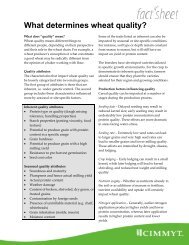

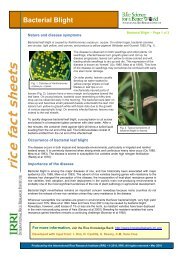

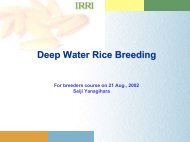
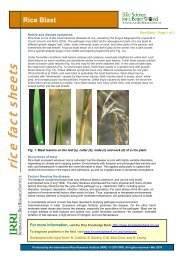
![International Standards' Organization â Rice Specification [ISO 7301]](https://img.yumpu.com/36696862/1/190x245/international-standards-organization-a-rice-specification-iso-7301.jpg?quality=85)

